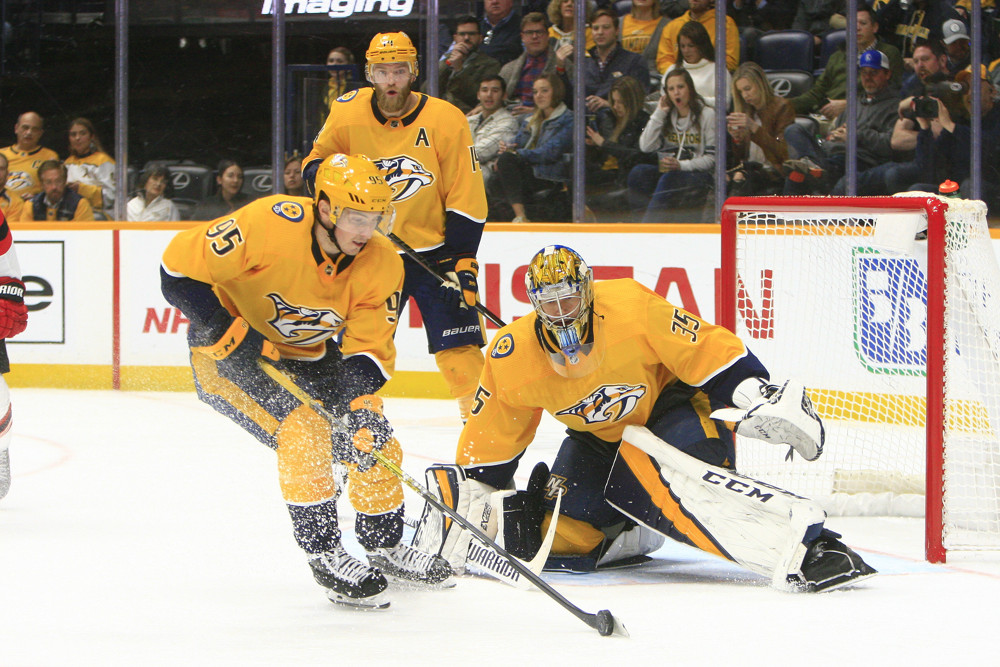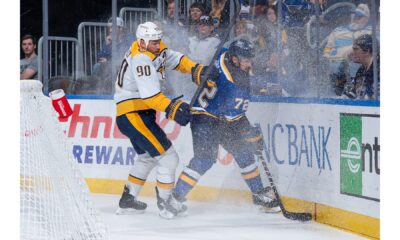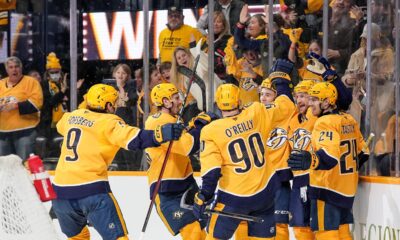
The Nashville Predators are approximately ⅓ of the way through their 2019-20 season. A couple of obvious statements to get out of the way: the year has not gone how the team or its fans expected so far, and the results are quite disappointing. The season started out in promising fashion, with Nashville going 8-3-2 in October, averaging more than 4 goals per game, and scoring at least 5 goals in 6 of those 13 games.
October ended on a scary note, however, when Nashville lost 6-5 in a shootout to Calgary after taking a 4-1 lead into the 3rd period. We will never know whether this game had anything to do with the team’s struggles or not, but the fact is, things haven’t been the same since Halloween night. The Predators have won just five of their 15 games since the calendar changed to November, and currently sit in 6th place in the Central Division with an overall record of 13-10-5.

So, what’s going on with the Nashville Predators? It is clear that there is more than one issue (maybe even more than a few) that need to be fixed to get back on track. A great many problems can — and have — been discussed by just about every media member who covers the organization. Still, there are a few interesting things that catch my attention.
Can’t Get In (or Out of) the Zone
This first issue is one I admit I do not have any real data on, nor do I even know for sure that such data exists. Regardless, think of what it has been like to watch Nashville play this year. As the team skates into the offensive zone, what seems to be the most common result? If you’re like me, you’re probably picturing the individual having a lot of trouble getting the puck across the blue line cleanly. There is always pressure on the puck, causing the skater to dump the puck in deep and hope someone can get possession, or Nashville mistimes their entry altogether, resulting in an offside play. I can say with confidence that Nashville struggles mightily when it comes to entering the offensive zone, and struggles almost as much maintaining possession if they do. On the other end of the ice, the exact opposite seems to happen for the Predators’ opponents. They often have little to no trouble getting in the zone, and routinely can keep possession for extended periods. Why is that?

The most obvious problem is movement, both of the puck and people. Offensively, Nashville is consistently stagnant with the puck, holding it until the last second, allowing the defense to move aggressively, cutting off angles for shots and getting sticks in passing lanes. This, combined with the Predators’ passing being not entirely crisp and accurate, results in the puck either being knocked out of the zone or turned over entirely. On the defensive side, Nashville is not nearly as aggressive as their opponents, allowing them to pass and move quickly, finding open space on the ice and creating quality scoring chances.
When the Predators do get their stick on the puck in the defensive zone, they have trouble clearing it, either holding too long to try to find the perfect pass, or simply attempting a clear that ends up going straight to an opposing player. A perfect example of this was the end of the Vegas game before Thanksgiving, when the clock was counting down to what seemed like a win for the Preds, but Dan Hamhuis tried to hold the puck in the corner. He failed to maintain possession, and Vegas eventually got the puck in front of the net for a shot that got by Juuse Saros, tying the game with less than half a second left. The Golden Knights ended up winning in overtime.
Power Play Weakening, PK Getting Killed

Let’s quickly revisit the power play struggles of last season. The Predators were anemic on the man advantage, and it proved to be part of their downfall in the end. They converted on just 12.9% of their opportunities, good for 31st in the league, according to NHL.com statistics (and basically everyone who reported on the team last year). Had they produced at even a mediocre level, we would probably have seen Nashville play at least a little longer into the postseason.
So, the Predators went to work this summer, hiring Dan Lambert as a new assistant coach to fix the power play, among other responsibilities. They acquired Matt Duchene in free agency to spark more offensive production in general, but also to help bolster to power play unit. Things seemed to be turned around at the beginning of the season. Through their first 13 games, Nashville was converting PP chances at a rate of almost 22%. It wasn’t the best in the league, but it was significantly better than the season prior. Since then, however, the Predators’ power play has dropped off significantly, and they are now converting just 15.5% of their 5-on-4 opportunities for the season, currently 24th in the NHL.
On the flip side, Nashville has struggled killing off penalties they commit. Opposing teams are converting 75.8% of power play chances against the Predators. This number is currently 6th worst in the NHL. Nashville is in the middle of the pack (17th) as far as total penalty minutes, but teams have still scored a high volume of PP goals against. For example, Nashville has played Vancouver twice so far this season. The Preds have been shorthanded a total of 9 times between those two games. How many power goals did the Canucks score in those opportunities? Eight. Eight! That is obviously an outlier as far as the statistics go, but it is not a recipe for success when it comes to winning games in the NHL.
“Lineup decisions”
I won’t beat a dead horse by going into the Kyle Turris saga in too much detail right now, but the basic gist is this: after a disastrous season last year, Kyle Turris started this campaign in relatively productive fashion, tallying 4 goals and 9 points in 19 games. No, this is not a pace that will get the attention of All Star voters, but it still points to him finishing the season drastically better than his 2018-19 totals of 7 goals and 23 points. After those first 19 games, Turris was quite inexplicably scratched for the next 7. Head coach Peter Laviolette called it a simple “lineup decision” multiple times when asked, and eventually got a little defensive when the questions persisted.
The most interesting part about the whole scenario is that after Viktor Arvidsson was sidelined 4 to 6 weeks with a lower body injury, the organization chose to call up Daniel Carr and Mathieu Olivier from Milwaukee, rather than insert Turris back into the lineup. Carr has fared better in the NHL this time around than he did after originally making the roster at the beginning of the season, but you still have to wonder if Turris might have been able to contribute more than Carr.
Olivier is an even more curious choice. He clearly had a different role on the ice than Carr or Turris, and he didn’t necessarily play badly. He just ended up not really contributing much to the team, and eventually was barely on the ice, even though he was in the lineup. In his 8 games with the Predators, Olivier averaged just around 7:30 of ice time per game, including only playing for 5:30 against the Panthers in his penultimate game before being reassigned to the AHL. This begs the question: whatever his role, wouldn’t it make more sense to use someone who would play a little more, and therefore have more of a chance to contribute?
Time to Panic?
Probably not yet? But, if the Predators’ run of losing 6 straight and 8 of 9 games concerned you (which it should have), I’d say your concern-o-meter should be at least elevated now. While Nashville has been struggling, most of the Central has been winning. The Predators are just two points above the last place Chicago Blackhawks, trail the divisional playoff spots by 6 points, and are 3 points out of the Wild Card picture. This is not good news for this point in the season.
There are still plenty of games left to play. But the Predators are in an extremely competitive division, and the longer they take, the harder it will be to climb back up in the standings. Yes, the St. Louis Blues were dead last in the league last season as of January 1st, and became the Stanley Cup Champions, but that was a historic feat. It had never been done before. It’s reasonable to assume it will take a long time for it to happen again, if it ever does.
In hockey, as in many aspects of our world, things are often never quite as good or as bad as they may seem. In reality, the Nashville Predators are likely not as good as their 8-3-2 start. The good news is, they’re probably not as bad as they’re current 5-7-3 run, either. But, as the season progresses, the team will inevitably drift toward one of these extremes or the other. Which one will it be? They certainly have the talent to be a high achieving team, and I truly believe they’re playing hard, but Nashville needs the rest of the year to trend more toward October. Otherwise, there will be no choice but to call 2019-20 a bitter disappointment.


















